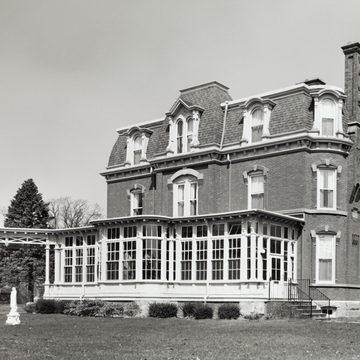You are here
Scalabrini Villa (John Carter Brown House)
This ambitious Second Empire villa was built by John Carter Brown on land adjoining his father-in-law's summer home as a retreat from his late-eighteenth-century mansion in Providence. It is an unusually high-style house for nineteenth-century North Kingstown, with pressed brick walls, fine dressed granite trim, and a convex mansard. The symmetry of its central pavilion is offset by an aggressively corbeled and patterned chimney set in a swelling easterly bay and a delicate stickwork portecochere to the west. A bracketed porch running the length of the house once provided views southward over sloping lawns, now filled with sprawling one-story residential development. The first floor interiors retain some of their original detail, including tiled fireplace surrounds and an unusually fine brass newel post lamp. To the rear is a handsome Colonial Revival barn. In 1907 the Brown family gave the house and 100 acres to the Rhode Island Hospital for use as a summer home for crippled children. In 1957 it passed to the Society of St. Charles, which operates it as a nursing home.
Writing Credits
If SAH Archipedia has been useful to you, please consider supporting it.
SAH Archipedia tells the story of the United States through its buildings, landscapes, and cities. This freely available resource empowers the public with authoritative knowledge that deepens their understanding and appreciation of the built environment. But the Society of Architectural Historians, which created SAH Archipedia with University of Virginia Press, needs your support to maintain the high-caliber research, writing, photography, cartography, editing, design, and programming that make SAH Archipedia a trusted online resource available to all who value the history of place, heritage tourism, and learning.














